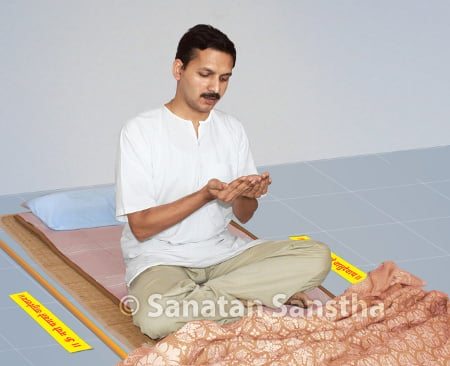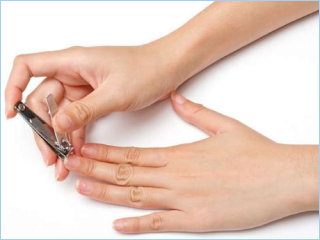1. Waking up at the Brahmamuhurt
As agreed by scriptures, wake up at the Brahmamuhurt. A prahar (Unit of time) before sunrise has two muhurts (Auspicious time), the first one called Brahmamuhurt. At this time, the human intellect and the energy for compiling a Holy text is good. Hence, the noun Brahma is prefixed to this muhurt. (Kulluk Bhat’s commentary on Chapter 4, Shloka 92 of Manusmruti)
A. Importance of Brahmamuhurt
1. Egoless Divine souls become active during this period.
2. This period is predominant with the Sattva component which enhances knowledge. The intellect during this period is pure and radiant. Brahmamuhurt is the best period for performing tasks related to the acts of Dharma and artha (Material gain), for considering Vedic principles and introspection.
3. During this period, the process of imbibing virtues like purity of the body and mind, ability to remain engrossed in karma (An act), gaining knowledge, donation, control over the senses, performing of austerities, truth, Shanti (Serenity), compassion towards all creatures, absence of greed, being ashamed of performing condemnable deeds, stability, radiance and purity becomes easier.
4. Mosquitoes, bedbugs and fleas become weak during this period.
5. Dominance of negative energies is also weakened during this period.
– Gurudev Dr. Kateswamiji
2. Normally, why do we yawn after waking up?
The gases generated in the body at night are expelled through the mouth in the morning, resulting in yawning.
The mouth is an opening for removing of Vayu (gases). Sattva-uttprerak (Stimulating the functioning of Sattva component) gas functional in a person is released along with words that it utters and imparts momentum to the subtle form of these words. Since the gases generated in the body at night are not expelled through the mouth during sleep, they accumulate in the body and are activated in the morning thus expelled in large proportion through the mouth of a person. That is why we yawn.
– A Knowledgeable One (Through the medium of Mr. Nishad Deshmukh, 19th June 2007, 3.51 p.m.)
3. Activities to be performed upon waking up
A. Shrotrachaman
Upon waking up, before getting out of bed, perform Shrotrachaman. Even if water is not by your side, perform Shrotrachaman without fail. – Shri Gurucharitra, Chapter 36, Stanza 124. Shrotrachaman means touching the right ear with the right hand and reciting the twenty-four Names of Shrivishnu, starting from ‘Om Shri Keshavaya Namaha’. Since the Deities Aditya, Vasu, Rudra, Agni, Dharma, Ved, Apa, Som, Anil etc. all dwell in the right ear, even the touch of the right hand to the right ear gives the result of an achaman (Sipping water from the cupped palm thrice, while uttering the first three of the twenty-four names of Shrivishnu and releasing the water into a plate from the palm while uttering the fourth name). Achaman leads to internal purification.
B. Reciting shlokas
1. Salutations to Shri Ganesh
वक्रतुंड महाकाय सूर्यकोटि समप्रभ ।
निर्विघ्नं कुरु मे देव सर्वकार्येषु सर्वदा ।।
Meaning : O Shri Ganesh, the destroyer of evildoers, the powerful one, who has the radiance of a thousand suns. Let all my actions be accomplished without any obstacles.
2. Salutation to the Deity
ब्रह्मा मुरारिस्त्रिपुरांतकारी भानुः शशी भूमिसुतो बुधश्च ।
गुरुश्च शुक्रः शनिराहुकेतवः कुर्वन्तु सर्वे मम सुप्रभातम् ।।
Meaning : May the trinity of Deities – Brahma the Creator, Shrivishnu the Nurturer and the slayer of the demon Moor, Shiva the Destroyer and slayer of the demon Tripur, and the nine Cosmic bodies Surya (Sun), Chandra (Moon), Mangal (Mars), Buddh (Mercury), Guru (Jupiter), Shukra (Venus), Shani (Saturn), Rahu (Neptune) and Ketu (Pluto) make my morning auspicious.
3. Remembering virtuous souls
पुण्यश्लोको नलो राजा पुण्यश्लोको युधिष्ठिरः ।
पुण्यश्लोको विदेहश्च पुण्यश्लोको जनार्दनः ।। – Punyajanastuti, Shloka 1
Meaning : I remember the virtuous Nal, Yudhishthir, Videh (King Janak) and Shri Janardan.
4. Remembering the Saptachiranjivs (Seven eternal souls)
अश्वत्थामा बलिर्व्यासो हनुमांश्च बिभीषण: ।
कृप:परशुरामश्च सप्तैते चिरजीविन: ।। – Punyajanastuti, Shloka 2
Meaning : Ashwatthama, the son of Dronacharya, the generous King Bali, Ved Vyas, Hanuman, Bibhishan, Krupacharya, and Parshuram who eliminated Kshatriyas (One who belongs to the second of the four varnas (Classes), namely the warrior class) from the earth twenty-one times, are the seven chiranjivs (immortals). Hence, revere them.
5. Remembering the Panchamahasatis (Five great chaste women)
अहिल्या द्रौपदी सीता तारा मंदोदरी तथा ।
पञ्चकं ना स्मरेन्नित्यं महापातकनाशनम् ।। – Punyajanastuti, Shloka 4
Meaning : The severest of sins of an individual who recounts the greatness of Panchamahasatis (that are, Ahilya [Wife of Sage Gautam], Droupadi [Wife of the Pandavs], Sita [Wife of Shriram], Tara [Wife of King Vali] and Mandodari [Wife of Ravan]) are wiped off.
6. Remembering the seven Mokshapuris (Places that bestow Moksha (Final Liberation))
अयोध्या मथुरा माया काशी कांची ह्यवंतिका ।
पुरीरावती चैव सप्तैता मोक्षदायिका: ।। Shri Bruhannardiya Puran
Meaning : Ayodhya, Mathura, Mayavati (Haridwar), Kashi, Kanchi, Avantika (Ujjaini) and Dwarka are the seven places that bestow Moksha. I recount their greatness.
C. Kardarshan (Looking at the palm)

Kardarshan (looking at the palm)
Recite the following shloka (Shlokas ) by cupping the palms and concentrating on them.
कराग्रे वसते लक्ष्मी: करमध्ये सरस्वती ।
करमूले तु गोविंद: प्रभाते करदर्शनम् ।।
Meaning : The fingertips of the palm is the dwelling of (Goddess) Shri Lakshmidevi, the central portion of the palm is of (Goddess) Shri Saraswatidevi and the base of the palm of Deity Shri Govind; hence, one should look at the palms immediately after waking up in the morning.
(Variation: Deity Brahma resides at the base of the palms.)
1. Implied meaning of the shloka
1 A. Implied meaning 1
1. Importance of Shri Lakshmidevi
Shri Lakshmidevi is present on the fingertips of the palms, meaning, the external materialistic part resides in the form of Shri Lakshmidevi. Thus, Shri Lakshmidevi (not just wealth, but the five Cosmic Principles, food, clothing etc.) is necessary in materialistic life.
2. Importance of Shri Saraswatidevi
While acquiring wealth or Lakshmi, if there is absence of knowledge and caution, then Lakshmi proves to be alakshmi (Misfortune) leading to destruction; hence, the need for Saraswati.
3. Everything is Govind (Shrivishnu)
Govind is the one who resides in the form of Saraswati in the middle and as Lakshmi at the fingertips of the palms. While praising Deity Shiva and Devi Parvati in His Holy text Amrutanubhav, Saint Dnyaneshwar says, ‘Though the base, middle and fore portions of the palm look different from each other, it is Shri Govind Himself who functions through them. Almost every activity is performed by the fingertips, hence, Shri Lakshmidevi resides there; however, if the flow of knowledge arising out of experience and branched off from the core flow does not reach the palm, then without it, the hand cannot perform any activities’.
– H.H. Parshram Pande Maharaj, Sanatan Ashram, Devad, Panvel
1 B. Implied meaning 2
1. Maya (Great Illusion) in all its splendour and enticing manifest form, meaning, Shri Lakshmidevi and the basic unmanifest form of Shri Govind are one and the same. The one imparting this knowledge is Shri Saraswatidevi, who is the welfare provider and bestower of knowledge.
2. Lakshmi, Saraswati and Govind denote karma (Action which gives rise to destiny), dnyan (Spiritual knowledge) and bhakti (Devotion) respectively. When these three unite, only then can we unite with God.
3. Only if karma is performed with devotion, supported by knowledge, a balance is struck between pravrutti (Active in worldly life (opposite of nivrutti), inclined towards participation in worldly affairs) and nivrutti (Cessation of participation in worldly affairs), thus helping to lead a perfect and beautiful life justifying the Chaturvarnashram (System of four classes and stages) and ultimately, merging with God.
4. Such a person becomes a nishkam-karmayogi (Selfless seeker practising Karmayoga).
This has been explained in Gurukrupayoga. A person who performs spiritual practice as per this Path gains knowledge in a shorter time and makes faster spiritual progress, compared to those who perform spiritual practice through other Paths. (Sanatan Sanstha advocates spiritual practice according to Gurukrupayoga.
– Mrs. Anjali Kanaglekar, Sanatan Ashram, Ramnathi, Goa
2. Cupping of the palms creates a Brahmamudra that activates the Sushumna-nadi, which helps in removing the Tama component generated in the body during sleep at night
Recitation of the shloka, ‘ कराग्रे वसते लक्ष्मी: करमध्ये…..’ while concentrating on the cupped palms attracts Divine waves from the Universe towards the palms. These, divinity predominant waves, get concentrated on the palms, and by acquiring the expansiveness of the Akash-tattva (Absolute Ether Principle), remain in the hollow created by cupping of the palms. The cupping of palms creates a Brahmamudra which activates the Sushumna-nadi , thus favouring spiritual progress of the person. If sleeping all night has caused accumulation of the Tama component in the body, then its removal is facilitated by activation of the Sushumna-nadi. – A Scholar (Through the medium of H.H. (Mrs.) Anjali Gadgil, 29th October 2007, 9.46 a.m.)
D. Bhumivandan (Salutation to Mother Earth)
After reciting the shloka,‘कराग्रे वसते लक्ष्मीः …..’, pray to Mother Earth, recite the following shloka and then step onto the ground.
समुद्रवसने देवि पर्वतस्तनमंडले ।
विष्णुपत्नि नमस्तुभ्यं पादस्पर्शं क्षमस्व मे ।।
Meaning : O Goddess Earth, You are adorned with the ocean as your attire, and mountains as your breasts; You are the wife of Shrivishnu. I pay obeisance to You. Please forgive me for treading on You with my feet.
A. By stepping on the ground after praying to Mother Earth and recitation of the shloka, ‘समुद्रवसने देवि……’ the distressing vibrations which accumulated in the body as a result of the Tama component generated due to sleep at night, are dissipated into the earth.
– A Scholar (Through the medium of H.H. (Mrs.) Anjali Gadgil, 29th October 2007, 9.46 a.m.)

 Nine benefits of waking up at the Brahmamuhurt
Nine benefits of waking up at the Brahmamuhurt How to plan your day effectively?
How to plan your day effectively? Astrological viewpoint : On which days should nails be cut?
Astrological viewpoint : On which days should nails be cut? Varsha Rutucharya – a key to remaining healthy during the rainy season
Varsha Rutucharya – a key to remaining healthy during the rainy season Actions required to be performed after cleansing the teeth
Actions required to be performed after cleansing the teeth Cleansing the teeth
Cleansing the teeth
Hi, is Rahu and Ketu North and South Lunar Nodes or is Rahu and Ketu the planets Neptune and Pluto respectively?
Namaskar,
Rahu and Ketu are the North and South Lunar Nodes respectively.
Thank you for creating this content.
We need such content in this era.
This is so helpful 🙏
Thank you for the detailed explanation and walking us through the importance of these practices